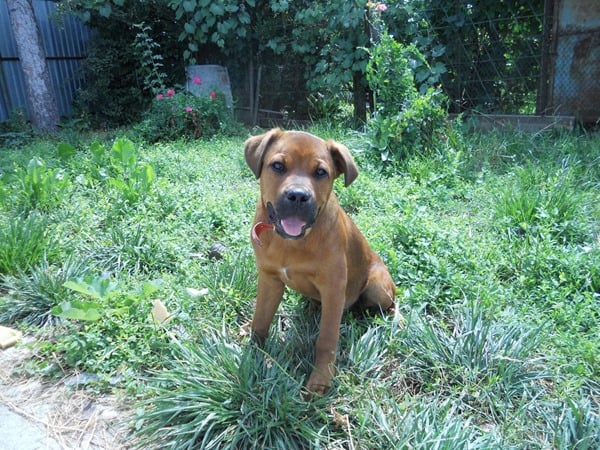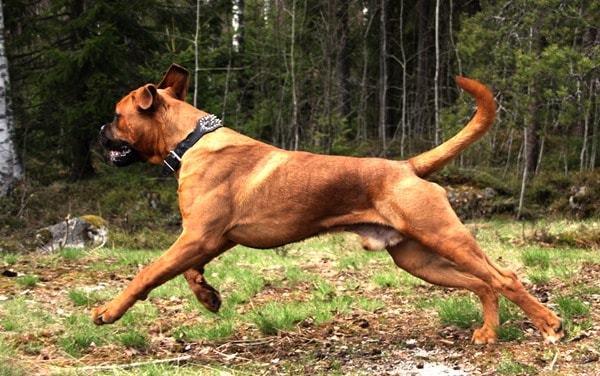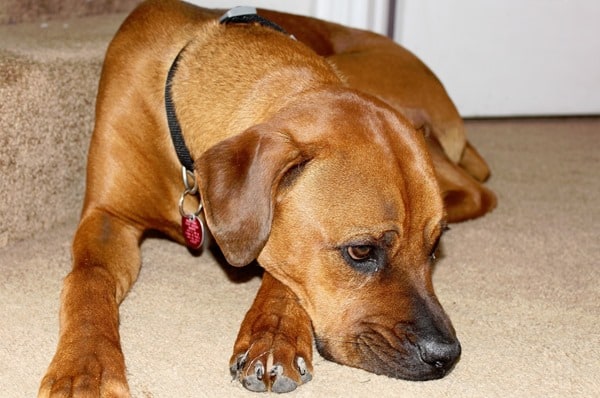The Boxweiler is cross-breed between the Boxer and the Rottweiler. Both Boxer and Rottweiler are very popular breeds so finding a mixed breed dog between them should be easy.
The Boxweiler combines the playfulness of the Boxer with the power of the Rottweiler. It is a super energetic and intelligent lively companion.
This mixed breed dog also goes by various other names, such as Box Rotty, Boxer Rottie, and Boxie Rottie. They are known to inherit some of the best qualities of both parents, making them loyal, bright, and loving.
Every Boxweiler is a unique combination and, in general:
-Need a yard and need a fairly amount of exercise
-Have some health issues, so be careful to choose a healthy one
-Need moderate grooming
-Are smart and trainable with patience
-A great dog for a family with older children
Boxweilers are large dogs that grow to be between 21 and 27 inches tall and weigh between 53 and 130 pounds. They also have a lifespan of 11-15 years if properly taken care of. While the sicker ones might not live past 8.
Boxweiler Recommended Products
These are products that you could need for your new Boxweiler, or for other medium to large dogs in general. These are all high quality and recommended by those that bought them in the past.Quick – Pros & Cons
Boxweilers are excellent guards and watchdogs and live happily with both single people and big families with children. Their energetic side requires a backyard but they can also live in apartments if you have the time to take them out 1-2 hours a day.
This mix between a Boxer and a Rottweiler is known to be just as intelligent as its parents and even more energetic and friendly. At the same time, it will protect you with everything it has if there’s a threat.
You’ll need to be careful while choosing a Boxweiler as some of them are more prone to illness than others, especially the white ones.
Pros
Highly intelligent
Excellent watchdogs
Great working dogs
Very friendly
Protective
Cons
They are extremely active, making them a not-so-great choice for busy people and the elderly.
Require a lot of training and socialization early on, not ideal for first-time dog owners.
Temperament
Boxer and Rottweiler are excellent guarding and police work breeds. This trait is also present in the Boxweiler. It is a trustful friend who will also work for you as it can operate as a working dog and not just a pet, being able to assist humans in certain areas.
Behavior-wise, this is a loyal, dynamic cheerful play-mate. They enjoy being close to humans and finding pleasure in outside activities whether it’s a walk, swimming, or just a ball game.
It is important to be well socialized with other pets or kids as early as possible as, towards strangers, it can be a bit circumspect.
They need to consume their bursting energy so a house with a yard would suit them perfectly. If kept in an apartment, they need daily exercise to keep them from getting bored and overweight.
Boxweilers are good family dogs. Their joyful personality makes it wonderful with children while being protective to its family and a good guardian dog not allowing strangers to enter a home without the owner’s approval.
Is a Boxweiler good with children?
The Boxweiler is a pretty large dog. This means that regardless of how well-trained and sweet he is, there might be injury simply because he’s so much larger than your small child. They prefer older children.
If your child is old enough to know how to properly play with a dog, the Boxweiler makes an amazing companion. He’s smart but very gentle and sweet. And their energetic nature matches perfectly to your older kid’s bursts of energy.
If your Boxweiler has the chance to grow up surrounded by children it would be perfect. This means you will need a lot of time on your hands to train him properly but it will definitely be worth it. They are natural nannies.
Boxweilers need socialization from a very young age. If you don’t have children yet, you can take the puppy on a walk next to a children’s park and allow them to gently pet him under your supervision.
Behavior towards strangers
Boxweilers are excellent family dogs and will do anything to protect you and guard your home. This is why they’re wary of strangers and will alert you of visitors before they even make it to your doorbell.
They also make excellent companions for travelers. If you love hiking, exploring, and visiting new places all the time, this dog will protect you while also making an amazing traveling friend.
To ensure that your Boxweiler won’t ever go too far with strangers that are not a threat you will need to expose him to proper socialization. This means meeting as many new people and pets as possible from the day you brought him home.
You should also be very careful of children and even adults that will try to get your dog angry when they see him in your yard just for amusement. Abusive passersby are the main reason dogs grow up to be aggressive towards strangers.
How it does with other pets/dogs
One thing you should keep in mind about this dog is that he will bound with only one master. He will still get along perfectly with the other family members but he will only see one person as the Alpha. This also makes them jealous dogs.
You can train a Boxweiler to tolerate another pet in the house but they will always prefer to be the only pet you have, especially the only dog. If you raise your Boxweiler together with your other pets he might grow up being best friends with your cat. It’s not impossible.
But generally, you will need to put a lot of work into making your Boxweiler accept the other pets if he hasn’t grown around any. You’ll need to introduce them slowly and calmly and wait for them to bond on their own terms.
Aggressiveness of a Boxer and Rottweiler Mix
The Rottweiler can be a very vicious dog so it’s only normal to question whether any of that anger made it to your Boxweiler. Generally, Boxweilers behave much better and are nowhere near as aggressive because they take their personality from the Boxer.
You might end up with an aggressive Boxweiler if the Rottweiler parent has been trained and bred for aggressiveness. But otherwise, there’s little chance you’ll end up with an aggressive mix of Boxer and Rottweiler.
To ensure that there won’t be an ounce of aggressiveness in him when he’s older, you’ll need to socialize him as early on as possible. More than that, it’s best to spoil them a little bit and offer them lots and lots of attention and cuddles. This way, you’ll raise a gentle teddy bear.
Does it bark a lot?
Both Boxers and Rottweilers have a very strong and intimidating bark. Your Boxweiler will definitely inherit that but they’re not the type to bark uselessly. They don’t answer to other dogs and are not bothered by random passersby.
Boxweilers make amazing watchdogs because they will only bark with purpose, and that’s to alert you when a stranger approaches your home. Their strong bark also makes them unfit for small apartments as he will bother lots of neighbors.
This mix of Boxer and Rottweiler uses its size to intimidate rather than getting vocal. But if any boundaries are overstepped, he won’t hesitate to alert you as loud as he can. If you can’t handle his occasional alerting bark from time to time, maybe this big and loving watchdog is not the best choice.
Appearance and Grooming
Boxweilers are adorable dogs that have a kind and loving look while their muzzle shows how dangerous they can be when threatened. They can look like any of the parents but they usually have a more muscular body with a fawn coat.
You can expect your Boxweiler to have a large, square head and a long snout. Many people tend to be intimidated by a full-grown dog as they can look quite serious and ready to protect you at any time.
You should also keep in mind that mixing two pure breeds together can give various unexpected results. This is why some Boxweilers are much smaller or even larger than the usual size of a mix between a Boxer and Rottweiler.
They are average shedders and they need moderate grooming and weekly brushing. Your vet should tell you how to clean their ears, wrinkles, clip their nails, etc.
How big does it get?
Boxer male dogs grow to be between 22 and 25 inches and weigh between 65 and 75lbs, while females grow up to 21 – 24in and weigh between 55 and 70lbs.
Rottweiler males grow up to 24-27in and weigh between 95 and 135lbs, while the females grow up to 22-25in and weigh between 80 and 100lbs.
The mix between a Boxer and Rottweiler will grow up to be anywhere between 21 and 27 inches tall and weigh from 70 to 100lbs. But as mentioned before, you can have a Boxweiler that’s also smaller or larger than this. They’re still an unpredictable mix.
What does a Boxweiler look like?
The Boxweiler can resemble any of its parents, remaining a large dog (21-27 inches, 53-130 pounds), and, usually has a more Rottweiler-like face with dark eyes, a not so pressed black nose, and floppy ears. It can have a black mask on its muzzle.
Regardless of which parent the Boxweiler takes after, he will always have a square head. His body on the other hand, if he takes more after the Boxer parent, he will have a more lean muscular body. But if he takes after the Rottweiler parent, his body will be more stocky and muscular.
When it comes to a Boxweilers’ legs, they’re long and in proportion with his size. These dogs are also known for their deep chests. And since their skin is pretty thick, you can expect your Boxer and Rottweiler mix to have some wrinkles.
Appearance and color
Boxweilers have short hair regardless of what parent they take after. But when it comes to color, it typically has the same fawn look as the Boxer parent. Except for your dog’s wide chest and muscular body, the Boxweiler is more likely to take after the Rottweiler side of the family.
You can find a Boxweiler in various colors, even white. But they’re very rare and unfortunately, they’re known to being much more prone to deafness. Generally, Boxweilers come in some of these colors:
– Fawn
– Black
– Brown
– Brindle
– White
Type of coat
Its double coat is thick, short, and harsh, just like the parents have. The colors are more Boxer-like fawn or brindle but also any combination of black, white, and brown.
These dogs are not hypoallergenic and can shed from time to time. It’s ideal to brush and groom them every day so you can remove all the dead and loose hair.
Their coat helps them be comfy at both lower and higher temperatures, but it’s best to keep them in an area with temperate weather.
How easy it is to groom?
Boxweilers are not hard to groom as their short coat requires brushing only a few times a week. You can brush your dog daily but it’s not a must.
On the other hand, having wrinkles and floppy ears means being prone to bacterial infections. This will require you to use a clean and damp towel to clean your Boxweiler’s wrinkles and ears every day. Then use a dry towel to ensure your dog is all dry and ready to play.
You might have to clip the nails more than once a month, especially if they don’t get the exercise they need and don’t have the chance to wear them down a little bit.
Boxweiler Care Guide – Diet, Exercise & Health Issues
Boxweiler’s health is better than their parents. Still, it does inherit the snoring, hip dysplasia, and deafness characteristic of large breeds but also it can get arthritis as they get older, especially if they are overfed as puppies.
Caution is advised in feeding Boxer and Rottweiler mix puppies human food, as it can lead to premature growth and easily breakable bones. Also, they are prone to overheating if they are kept in sun for too long. Temperate weather suits them best.
Boxweilers will offer you company 11 to 15 years if properly taken care of. It’s advised to choose your dog carefully because the ones that are white are more likely to be deaf and more exposed to cancer, and the brown and black ones are more prone to Canine Parvovirus.
Diet Tips: What does it eat?
You should formulate your Boxweiler’s diet for a large breed with lots and lots of energy. But if you don’t offer them the exercise they need you can expect them to gain weight if they’re overfed. This means you need to be careful with the treats and not leave any food around your dog between feeding times.
Every dog is different so don’t try to put your dog on a specific diet without talking with your vet. It doesn’t matter if your friend’s dog thrives on it or not, your lovely friend needs a diet that’s formulated for all of his needs. Your vet will always know what exactly he needs.
Exercise Requirements: Keeping the dog in shape
Boxweilers are very active dogs, as are both parents. This means you either need a house with a backyard or the time to offer your furry friend the exercise he needs. This includes at least half an hour a day of walking.
The ideal exercise time is an hour of running, walks, games, etc, per day. They might even gladly accept more exercise time if you can handle it. Boxweilers would love it if you’d introduce them to your hiking hobbies and take them with you.
Common Health Issues for a Boxweiler
Generally, Boxweilers are healthier than their parents. However, they still have their issues, especially as they get older. The common worries are always Hip Dysplasia, Dental Problems, Skin Problems, and Cataracts.
You should be ready to vaccinate your new furry friend for Rabies, Kennel Cough, Leptospirosis, Canine Coronavirus, Canine Parainfluenza, Canine Parvovirus, and Canine Distemper.
Boxweilers usually take their snout from their Rottweiler parents, making them prone to snoring and heavy drooling. They might also have some allergies that need to be found with the vet. And you should also keep in mind that they have separation anxiety if you live them alone all day.
Training a Boxweiler
Training these dogs requires patience and consistency. It is an intelligent dog and needs an owner who can be the leader of the pack. This way, from an early age, it will learn to listen and follow instructions.
Boxweilers take their parents’ strong protecting and herding instincts against both animals and humans. This is why you need to prove you’re the Alpha as soon as possible and start training them properly.
These dogs are highly intelligent and can be trained to help you out with work as well. This includes serving as a guard dog. But it’s always ideal to start from the simplest commands, such as Sit!, Stay!, and Lay Down!
Obedience Training
Both the Boxer and Rottweiler parents are known for their stubbornness and will not follow your commands until they take you seriously. And allowing them to disobey you will encourage them to be the leaders of the pack.
When training them you need to be clear, firm, and absolutely never heavy-handed. They respond best to firm but gentle commands and if you never give up. If you have some trouble training these dogs, call a professional and let them help you.
Socialization
Another important thing to a young Boxweiler is socialization. This will ensure that they grow to be very loving and never jump on a stranger and attack them while you’re out.
You need to start introducing him to new people, dogs, cats, places, go hiking with other friends that have dogs, etc. There are lots of ways to make your withdrawn and scared new puppy a social butterfly.
Exercise requirements
If a dog is bored, it will start destroying things around the house very quickly. This is why it’s important to keep your dog entertained most of the time.
You can opt for swimming, play ball, play mentally-stimulating games with him, and more. It would also be great to introduce him to your usual exercising schedule. But the minimum this breed needs is 30 minutes of walking.
Breeding & Puppies
These dogs have been bred for over 40 years and are now some of the most popular types of dogs in the world. This is because they mix the sweet and active personality of the Boxer with the muscular body of the Rottweiler.
Boxweiler puppies are even more active and they require constant attention and mental stimulation. They’re very smart and it’s best to start training them as soon as possible.
Giving him all the socialization and training he needs will result in a well-balanced companion. Be very gentle and firm with the puppies so they’ll learn as quickly as possible.
Finding a Rottweiler and Boxer Mix – Kennels & Pedigree
Boxweilers are a mix between two legendary pure breeds, the Boxer and the Rottweiler. And despite the fact that they’re widely popular everywhere, you can still find them in shelters.
Breeders are pretty easy to find but if you can afford to take care of a dog without knowing much about its parents it would be great if you’d go for adoption.
Both parents are pure breeds and are recognized by the American Kennel Club since the early 90s. But since Boxweilers are mixed breed dogs they aren’t recognized.
How much does a mixed Boxweiler cost?
Boxweiler puppies are not as expensive as you’d think. The prices range from $150 to $500, maybe $800 from the fanciest breeders in the world. But naturally, the money you spend purchasing the dog barely opens up your wallet.
You need to prepare to invest between $450 and $600 a year on medical needs. And between $500 and $650 a year on non-medical needs.
History & Origins of the mixed breed
Rottweilers were used in Germany to drove cattle and pull carts of meat. When the Romans got them, they used them as guard dogs. And now they are very popular as working dogs and in police work.
The Boxer dog also comes from Germany and they are themselves a mix from the German Bullenbeissers and the Bulldog. They were used as messenger dogs, pack carriers, and even as attack dogs in the military during WWI.
When it comes to the Boxweiler, their history is sadly very blurry, as it happens with mixed dogs. Despite the fact that both parents come from Germany, we don’t know for sure who, where, and why started to breed these two pure breed dogs.
Boxweilers are known to take the playful personality of the Boxer parent and the strength of the Rottweiler. But more than that, they inherit both parents’ alertness and agility, making them excellent watchdogs, guard dogs, and family companions.
Conclusion
Boxweilers are getting more and more popular all over the world and for good reasons. If you’re looking for a big dog that can protect you but that also loves to cuddle and play around, you can’t get much better than this mix between a Boxer and a Rottweiler.
They’re ideal dogs for people that have a lot of time on their hands, love to travel, and need a companion, people with big backyards, packed families, and as work dogs. But don’t get them if you can’t offer them the attention they need and you will leave them outside. They can easily get separation anxiety.
Sources for photos :







Bone growth tends to be done at one year…large dogs can continue to “fill out” up to 2yrs ..sometimes 3
I have puppy just looks like them but he’s 4 months 15.5 pounds. I’m really wondering if he ll be big or small size.
How do you know if they have hip problems.mine is 6 years old and has problems getting up sometimes. Is this something I need to worry about
Xrays are going to be the only way to find out. Glyde is the form of treatment we use at the vet clinic i work at. Its an Australian brand of hip and joint supplement and works wonders. Your pet is showing late signs of it. My recommendations would be to take him to his primary physician and get some xrays done along with the glyde and a joint supplement food like science diet J/D the good is also prescription but is the best one out there. All 4 of my large huskies and rotties are on both prescriptions.
Hip dysplasia is very uncomfortable and painful for your pet. IIs restrictions are no jumping on furniture and no stairs.
Hello I am looking for a boxweiler puppy does anybody have good breeders to recommend?
Thanks guys
Alguém sabe quem tem filhote de Boxer com rottweiler fêmea, estou desesperada para ter, é que a que eu tinha se foi e eu preciso ter outra. Desde já agradeço.
I rescued my Boxweiler at 9 weeks old. He weighed 7.5 lbs. His name is Copperpot. He will be 12 years old this June and weighs 96lbs.We live on a big farm and he’s an inside/outside dog (comes in goes as he pleases for most part). We’ve not ran into any heart problems as I’ve had him on a preventative medication and diet for such most of his life. He is however starting to have arthritic issues with his hips and elbows . I feel blessed we haven’t had to deal with any other issues thus far (knocking on wood) as the preventative care is seemingly doing well. I’ve found this mix to be the absolute best for the ease of training and his intellect is off the charts!